India 500 BC to AD 300
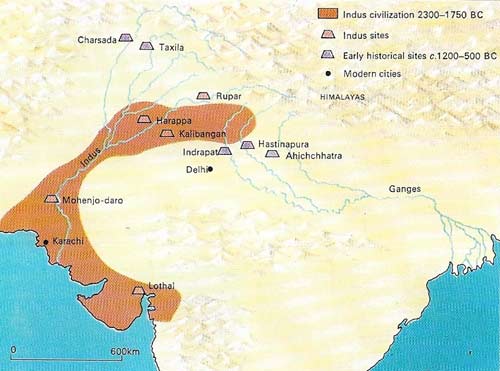
Figure 1. The brown areas on the map mark the expansion of the Indus civilization, stretching southeast down the coast to beyond the Gulf of Broach and eastwards far beyond present Delhi. The westward expansion into Baluchistan is not shown. All over this vast area – Rupar and Lothal are about 1,600 kilometers (1,000 miles) apart – the Indus civilization was uniform, suggesting centralized control. Political control was facilitated by the nature of the land as this civilization flourished in relatively dry areas which, unlike the tropical rain forest, could be cultivated without iron tools.
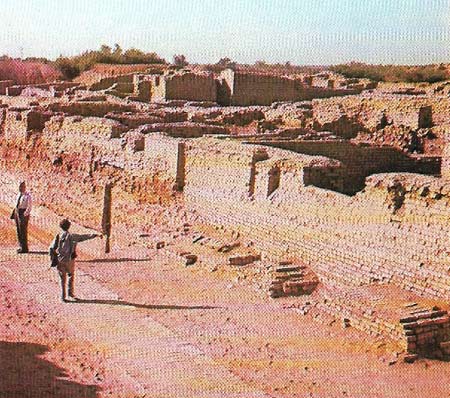
Figure 2. The ancient Indus city of Mohenjo-daro was built according to a systematic plan with streets crossing at right-angles and houses opening onto the streets. Elaborate granaries have also been found.
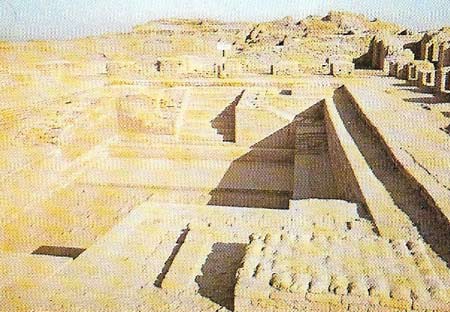
Figure 3. The Great Bath in the citadel of Mohenjo-daro was built of fine brickwork and presumably used for ceremonial functions. One of the most striking features of the Indus civilization was the importance attached to good water supplies. A well-built bathroom has been found in almost every house, which also possessed proper drainage. As a result each house has its own well, with a deep shaft which was kept in shape by means of terracotta hoops.
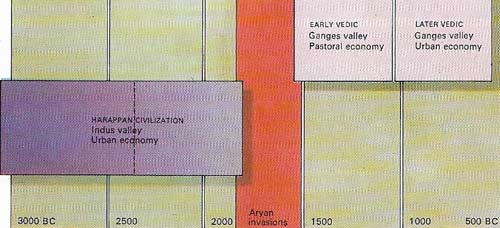
Figure 4. The earliest true history of the Indo-Pakistani subcontinent began when, after the middle of the third millennium BC, a high civilization emerged in and about the Indus valley. Once established, the Indus valley civilization flourished for more than six centuries without undergoing any significant changes. Its sudden end may have been due to Indo-Aryan invasions, but it seems more likely that these invasions took place when he Indus civilization had already disintegrated. The Indo-Aryans settled in villages in the Punjab and were divided into tribes, about which we know from the Rigveda. Between c. 1000 and 500 BC Indo-Aryan civilization gradually spread along the Ganges valley, as we can confirm from later Vedic literature, and early Hinduism took shape.
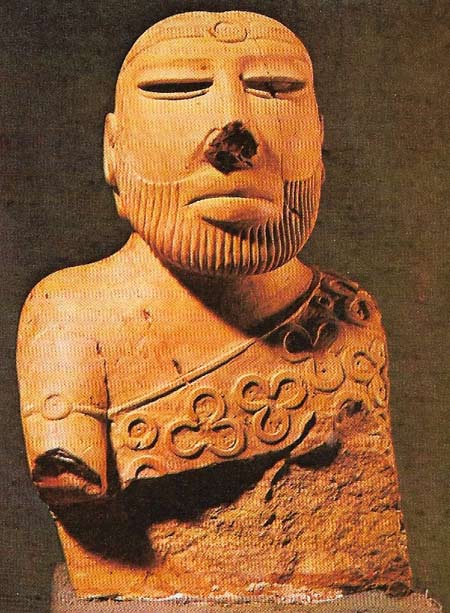
Figure 5. This limestone sculpture is one of the few surviving stone sculptures of the Indus civilization. It is 19 centimeters (7 inches) high and is apparently a portrait statuette representing a bearded man with low, receding forehead, elongated eyes, and thick lips. The sculpture reveals excellent taste and craftsmanship and gives some impression of the physical appearance of the ancient Indus people.
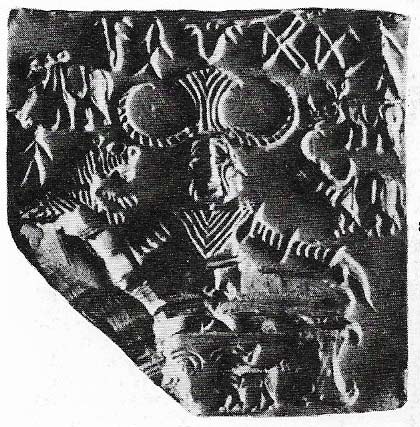
Figure 6. Most seals from Mohenjo-daro show representations of animals, sometimes composite or fantastic. This seal shows a three-headed, horned deity seated in an attitude that is reminiscent of the yoga asanas of later times. The god is surrounded by a number of animals. This, among other features, recalls later representations of the god Shiva. The deity has therefore been identified as a proto-Shiva.
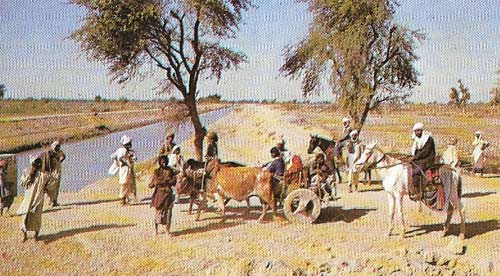
Figure 7. The modern inhabitants of the Mohenjo-daro area, like their predecessors, still use the river as their lifeline. The river was not only important for irrigation of the fields in the vicinity of its banks but it was also essential for communications. The striking uniformity of the Indus civilization would have been impossible without reasonable communications. Representations of boats have been found on stone and terracotta at Mohenjo-daro.
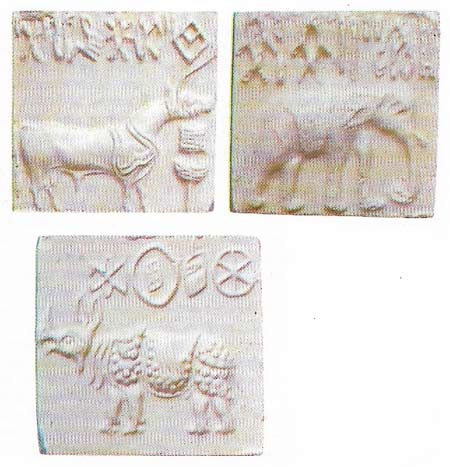
Figure 8. Three Mohenjo-daro casts from seals supply valuable information about the ancient Indus civilization, revealing, for example, that cattle had already been domesticated. These seals represent a bull feeding from a manger, an elephant and a rhinoceros. The writing is hieroglyphic but scholars have not yet been able to decipher it.
The earliest evidence of a literate culture in India dates from about 2300 BC when the Indus civilization emerged from the prehistoric age. This Indus or Harappan civilization (named after the town of Harappa) had its principal centers in the Indus valley, now mainly in Pakistan, but extended westwards to the present Iranian border, eastwards to beyond Delhi and southwards to the Gulf of Broach (Figure 1). Its main cities were at Harappa in the Punjab and Mohenjodaro in Sind, but there were also a number of smaller towns, including the port of Lothal.
The nature of settlements
The cities show advanced town planning and the remains testify to a high and diverse material culture (Figure 2 and 3). A considerable part of the now fairly arid Indus valley must have been brought under cultivation to yield the surplus crops with which to feed the city populations. Unless there has been a complete change of climate in this area since that time it is obvious that fields were irrigated.
Such a sophisticated civilization required a form of writing. Thousands of steatite (soapstone) seals (Figure 8) have been discovered. In addition to representations of animals, men and gods these present brief inscriptions in as yet undeciphered hieroglyphic script. The seals, some of which have been found as far away as Syria, were probably merchants' seals attached to goods.
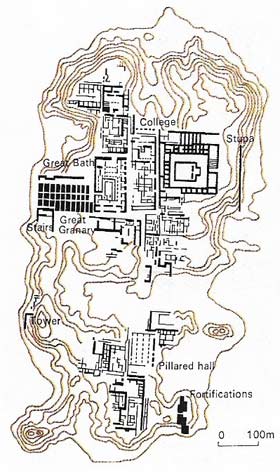 |
| The larger Indus cities all consisted of a citadel mound and a lower city complex stretching eastward from the citadel. The former was the site of most of the large public buildings such as, in Mohenjo-daro, the Great Bath, the granary and a building that on account of its shape (several courtyards, corridors, rooms and compartments} has tentatively been identified as a college. The lower city was the residential area. This ground plan of Mohenjo-daro shows the grid of the town in the lower part of the city and the houses, which vary greatly in size from those consisting of a single room to large residences boasting more than 20 rooms. |
The end of the Indus
Even less is known about the end of the Indus civilization than about its origins. After flourishing for five or six centuries (c. 2300–1750 BC) without undergoing much change it completely disintegrated following a brief decline. Although natural calamities cannot completely be excluded, it now seems that the Indus cities were ravaged by invading nomadic horsemen in the 18th century BC. The latter are usually identified as Indo-Aryans, for whose presence there is, however, no reliable evidence until about four centuries after the end of the Indus civilization. It is therefore more likely that the Indus cities were conquered by tribesmen from the mountains who, in their turn, gave way to the Indo-Aryans.
By the 13th century BC, the Indo-Aryans – split into numerous tribes who fought each other no less fiercely than the earlier inhabitants – had occupied the Punjab. They subsequently spread into the Ganges valley and southwards into Gujerat and Maharashtra.
A vast collection of religious hymns written in archaic Sanskrit, the Rigveda, dates from this early phase (c. 1400–1000 BC). Apparently preserved by oral tradition, the hymns are addressed to many different deities whose help is implored in military and agricultural pursuits. The four Vedic texts, of which the Rigveda is the foremost, spawned expositions and commentaries of which the Upanishads are the most celebrated. The gods, such as Indra, are usually conceived of as anthropomorphic, but some features – for example speculation about the true nature of the sacrifice – which were to he become characteristic of Hinduism, are already distinguishable.
During the later Vedic period (c. 1000–550 BC) the Indo-Aryans, by then utilizing effective iron tools, spread over most of northern India including the Ganges valley, burning down the forest to cultivate the fertile land. The gradual progress of this expansion can be traced with the help of a distinctive type of pottery, Painted Grey ware. These people were not urbanized as the Harappans had been. During their expansion they mixed with earlier established forest tribes, introducing them to the horse, and their mode of life changed from semi-nomadic cattle breeders to settled farmers.
This change had important political and cultural implications. The tribal units gave way to kingdoms based not on kinship but on territory. The kingdoms were controlled by warrior classes (kshatriyas) headed by the king, and assisted by members of the powerful class of hereditary priests (brahmins). These two ruling classes controlled the free peasants, traders, and craftsmen who constituted the third class (vaisyas), as well as the semi-servile laborers, hunters and fishermen who formed the lowest class of the sudras, partly descendants of forest tribes. Some of these, especially those whose way of life was considered unclean or repulsive by the Indo-Aryans, were assigned the status of untouchables. This marked the beginning of the complex caste system.
The rise of major cities
During this period major cities developed for the first time since the decline of the Indus cities. The most important were Hastinapura on the Ganges east of present-day Delhi and, in about 500 BC, Rajgir in southern Bihar, with its impressive walls. In the same period most of the basic concepts of Hinduism took shape: not only caste, but also the belief in the transmigration of the soul, in non-violence and in the holiness of the cow. These have all become lasting features of Indian civilization. While the Vedic sacrifice persisted and became more and more complicated, there was also a reaction among those who felt unsatisfied with formal religion and sought higher values in meditation. People of the ruling classes were encouraged to withdraw to a life of contemplation in the forest when their children no longer needed them. On this foundation Siddhartha Gautama (c. 563–c. 483 BC) instituted Buddhism.
